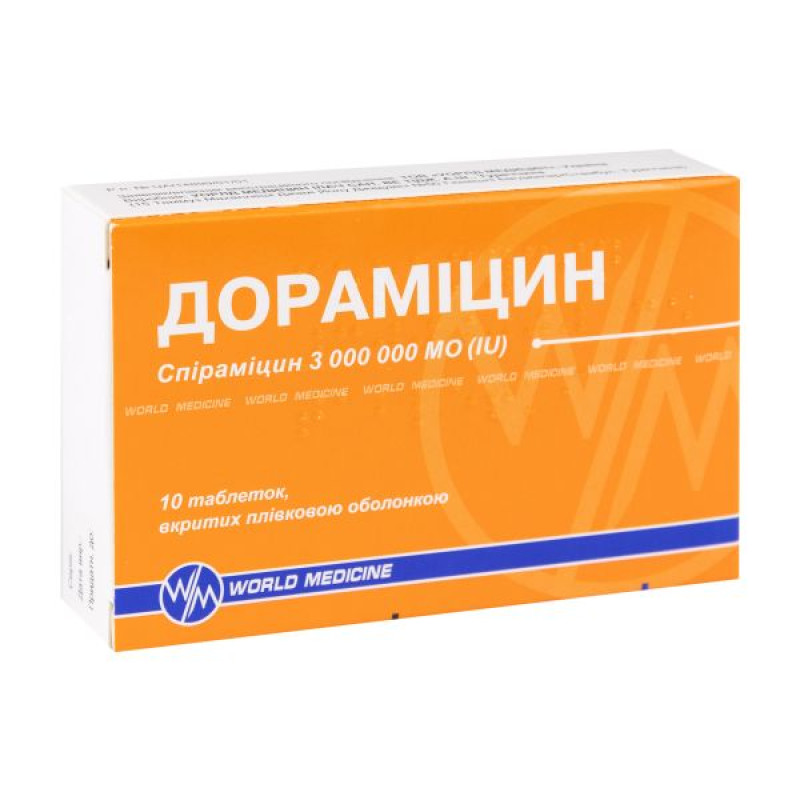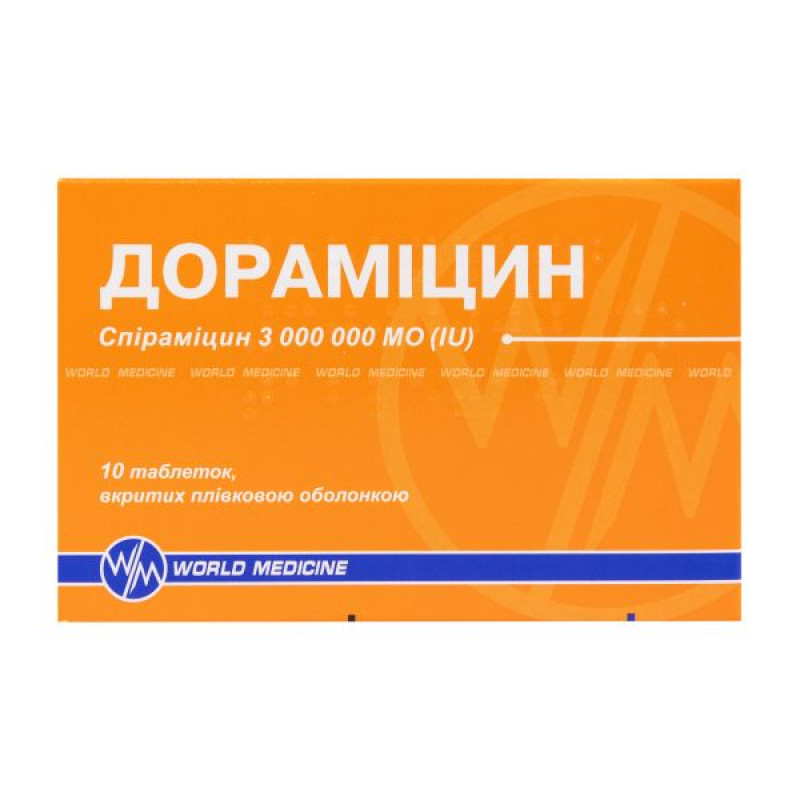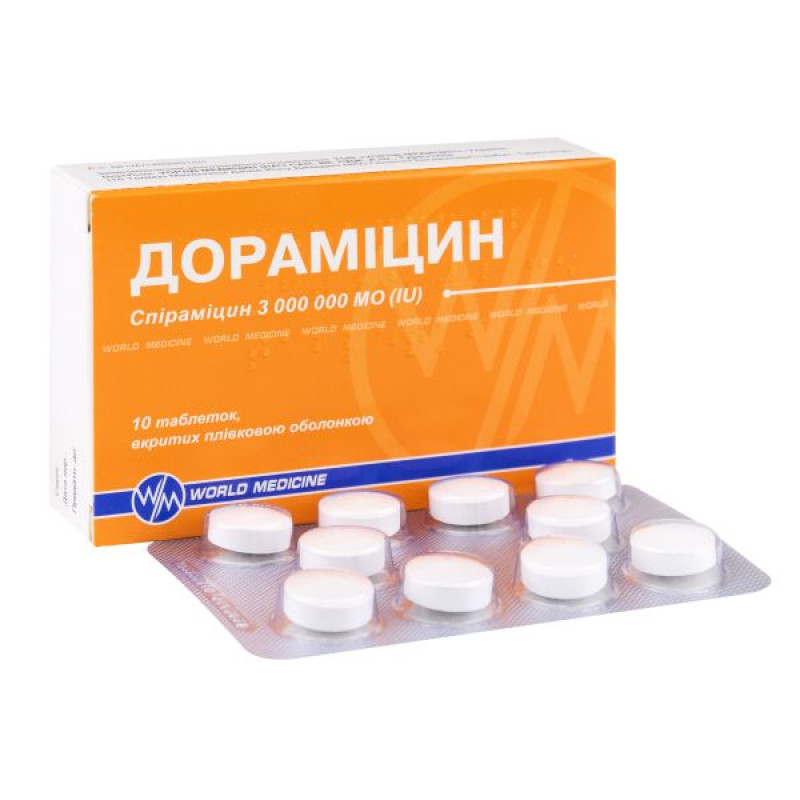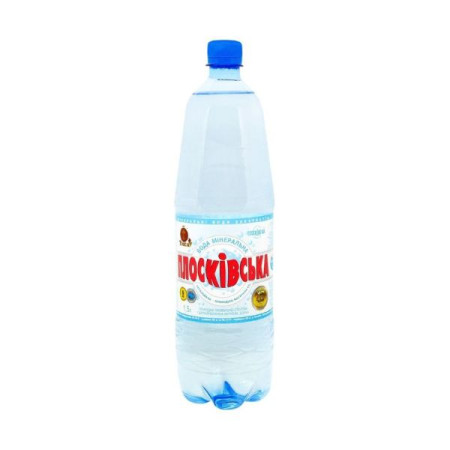Doramycin film-coated tablets 3000000 IU blister No. 10

Instructions Doramycin film-coated tablets 3000000 IU blister No. 10
Composition
active ingredient: spiramycin;
1 film-coated tablet contains spiramycin 3,000,000 IU;
excipients: corn starch, croscarmellose sodium, magnesium stearate, hydroxypropylcellulose, colloidal anhydrous silica, microcrystalline cellulose, Opadry® II White 85F18422 coating (polyvinyl alcohol, partially hydrolyzed; titanium dioxide (E 171); macrogol 4000; talc).
Dosage form
Film-coated tablets.
Main physicochemical properties: round biconvex tablets, film-coated, white or almost white in color, embossed with “DORA” and “3” on one side.
Pharmacotherapeutic group
Antibacterials for systemic use. Macrolides. ATX code J01F A02.
Pharmacological properties
Pharmacodynamics
Spiramycin is a macrolide antibiotic that has a bactericidal effect.
Spectrum of antimicrobial activity.
The critical concentrations that allow to differentiate sensitive species of microorganisms from species with intermediate sensitivity and the latter from resistant species are as follows: sensitive < 1 mg/l; resistant > 4 mg/l.
The prevalence of acquired resistance in certain species of microorganisms may vary geographically and over time. Therefore, it is useful to have local information on the prevalence of resistance, especially when treating severe infections.
The data provided only allow us to estimate the probability of susceptibility of a bacterial strain to this antibiotic. The prevalence of bacterial species resistant to spiramycin in France is shown in the table below.
| Category | Prevalence of acquired resistance in France (>10%) (range) |
| Sensitive species | |
Gram-positive aerobes Bacillus cereus Corynebacterium diphtheriae Enterococci Rhodococcus equi Staphylococcus methicillin-susceptible Methicillin-resistant Staphylococcus* Streptococcus B Unclassified streptococcus Streptococcus pneumoniae Streptococcus pyogenes | 50–70% 70–80% 30–40% 35–70% 16–31% |
Gram-negative aerobes Bordetella pertussis Branhamella atarrhalis Campylobacter Legionella Moraxella | |
Anaerobes Actinomyces Bacteroides Eubacterium Mobiluncus Peptostreptococcus Porphyromonas Prevotella Propionibacterium acnes | 30–60% 30–40% |
Various Borrelia burgdorferi Chlamydia Coxiella Leptospires Mycoplasma pneumoniae Treponema pallidum | |
| Moderately susceptible species (intermediate level of susceptibility in vitro) | |
Gram-negative aerobes Neisseria gonorrhoeae | |
Various Ureaplasma urealyticum | |
Anaerobes Clostridium perfringens | |
| Resistant species | |
Gram-positive aerobes Corynebacterium jeikeium Nocardia asteroides | |
Gram-negative aerobes Acinetobacter Enterobacteriaceae Haemophilus Pseudomonas | |
Anaerobes Fusobacterium | |
Various Mycoplasma hominis |
* The prevalence of methicillin resistance is 30–50% among all staphylococci and is typical for inpatient hospital wards.
The activity of spiramycin against Toxoplasma gondii has been shown in vitro and in vivo.
Pharmacokinetics
Absorption
After oral administration, absorption of spiramycin is rapid but incomplete and is independent of food intake. After administration of 6,000,000 IU of spiramycin, the maximum plasma concentration is 3.3 μg/ml.
Distribution
The degree of binding of spiramycin to blood plasma proteins is 10%. It does not penetrate the blood-brain barrier. However, it penetrates into breast milk.
Distribution in tissues and saliva is very high (lungs – 20-60 μg/g, tonsils – 20-80 μg/g, infected sinuses – 75-110 μg/g, skeletal bones – 5–100 μg/g).
10 days after cessation of treatment, the concentration of spiramycin in the spleen, liver and kidneys is 5 to 7 μg/g.
Macrolides penetrate and accumulate in phagocytes (neutrophils, monocytes, peritoneal and alveolar macrophages). In humans, the concentration in phagocytes is high. These properties ensure the effectiveness of spiramycin in the treatment of infections caused by intracellular bacteria.
Metabolism
Spiramycin is metabolized in the liver, resulting in the formation of active metabolites whose chemical structure is unidentified.
Breeding
The apparent half-life of spiramycin is about 8 hours. A large amount is excreted in the bile: the concentration of spiramycin in bile is 15–40 times higher than in blood plasma; a significant amount is excreted in the feces. 10% of an oral dose of spiramycin is excreted in the urine.
Indication
Treatment of infections caused by microorganisms sensitive to spiramycin: confirmed tonsillopharyngitis caused by group A beta-hemolytic streptococci (as an alternative to treatment with beta-lactam antibiotics, especially if they cannot be used); acute sinusitis (given the microbiological characteristics of the infection, the use of macrolides is indicated when treatment with beta-lactam antibiotics is impossible); superinfection in acute bronchitis; exacerbation of chronic bronchitis; community-acquired pneumonia in patients who do not have risk factors, severe clinical symptoms, clinical factors indicating a pneumococcal etiology of the disease. In case of suspicion of atypical pneumonia, the use of macrolides is advisable regardless of the severity of the disease and history; benign skin infections: impetigo, impetigo, ecthyma, infectious dermo-hypodermitis (especially erysipelas), erythrasma; oral cavity infections; non-gonococcal genital infections; chemoprophylaxis of acute rheumatic fever relapses in patients allergic to beta-lactam antibiotics; toxoplasmosis in pregnant women; prevention of meningococcal meningitis in individuals for whom rifampicin is contraindicated: to eradicate the microorganism (Neisseria meningitidis) in the nasopharynx; as prophylaxis: in patients after treatment and before returning to social life; in patients who have been in contact with a person with sputum discharge within 10 days preceding his/her hospitalization.
Spiramycin is not indicated for the treatment of meningococcal meningitis.
Official recommendations regarding the appropriate use of antibacterial agents should be followed.
Contraindication
Hypersensitivity to the active substance and/or to any of the excipients of the medicinal product. Use in patients at risk of QT prolongation, namely: patients with a personal or family history of congenital QT prolongation (unless this diagnosis has been excluded by ECG); patients with drug-induced QT prolongation or of metabolic or cardiovascular origin. Concomitant use with medicinal products that induce torsades de pointes ventricular tachycardia, such as: class Ia antiarrhythmics (quinidine, hydroquinidine, disopyramide); class III antiarrhythmics (amiodarone, sotalol, dofetilide, ibutilide); sultopride (benzamide neuroleptic);
others: arsenic preparations, diphemanil, dolasetron intravenously, mizolastine, levofloxacin, moxifloxacin, prucalopride, toremifene, vincamine intravenously, erythromycin intravenously, dronedarone, mehitazine, citalopram, disopyramide, dofetilide, domperidone, escitalopram, hydroquinidine, vandetanib (see section "Interaction with other medicinal products and other types of interactions").
Interaction with other medicinal products and other types of interactions
Ventricular tachycardia of the torsades de pointes type
This serious heart rhythm disorder can be caused by certain antiarrhythmic drugs or other drugs. Spiramycin for intravenous administration is a drug that causes ventricular tachycardia of the torsades de pointes type. Hypokalemia (with the use of diuretics that cause hypokalemia, stimulant laxatives, amphotericin B (intravenous), glucocorticoids, tetracosactide) contributes to its development, as well as bradycardia and pre-existing QT prolongation, congenital or acquired.
Concomitant use with the following agents is contraindicated:
Medicinal products that cause ventricular tachycardia of the torsades de pointes type (class Ia antiarrhythmics (quinidine, hydroquinidine, disopyramide), class III antiarrhythmics (amiodarone, sotalol, dofetilide, ibutilide), sultopride (benzamide neuroleptic), others (arsenic preparations, diphemanil, dolasetron intravenously, erythromycin intravenously, levofloxacin, mizolastine, moxifloxacin, prucalopride, toremifene, vincamine intravenously), dronedarone, mehitazine, citalopram, disopyramide, dofetilide, domperidone, escitalopram, hydroquinidine, vandetanib).
Concomitant use of spiramycin with such agents increases the risk of ventricular rhythm disorders, in particular ventricular tachycardia of the torsades de pointes type.
Concomitant use with the following agents is not recommended:
Antiparasitic drugs that can cause ventricular tachycardia of the torsades de pointes type (halofantrine, lumefantrine, pentamidine).
Concomitant use of spiramycin with such agents increases the risk of ventricular arrhythmias, including torsades de pointes. If possible, one of the drugs should be discontinued. If combined treatment cannot be avoided, the QT interval should be checked beforehand and ECG monitoring should be performed.
Neuroleptics capable of causing ventricular tachycardia of the torsades de pointes type (amisulpride, chlorpromazine, cyamemazine, droperidol, flupentixol, fluphenazine, haloperidol, levomepromazine, pimozide, pipamperon, pipotiazine, sulpiride, tiapride, zuclopenthixol).
Concomitant use of spiramycin with such agents increases the risk of ventricular rhythm disorders, in particular ventricular tachycardia of the torsades de pointes type.
Concomitant use with spiramycin increases the risk of ventricular rhythm disorders, in particular ventricular tachycardia of the torsades de pointes type.
Concomitant use with the following agents should be carried out with caution.
Drugs that prolong the QT interval
Spiramycin, like other macrolides, should be used with caution in patients taking drugs that prolong the QT interval (e.g. class IA and III antiarrhythmic drugs, tricyclic antidepressants, some antibacterial drugs, neuroleptics) (see section "Special warnings and precautions for use").
Concomitant use with the following agents requires special precautions.
Beta-blockers for heart failure (bisoprolol, carvedilol, metoprolol, nebivolol), drugs that cause bradycardia (in particular, class Ia antiarrhythmic drugs, beta-blockers, some class III antiarrhythmic drugs, some calcium antagonists, cardiac glycosides, pilocarpine, anticholinesterase drugs (ambemonium, donepezil, galantamine, memantine, neostigmine, pyridostigmine, rivastigmine)).
Concomitant use of spiramycin with such agents increases the risk of ventricular rhythm disorders, in particular ventricular tachycardia of the torsades de pointes type. In the case of combined treatment, clinical control and ECG monitoring should be carried out.
Agents that cause hypokalemia (diuretics that cause hypokalemia, alone or in combination with other drugs, stimulant laxatives, glucocorticoids, tetracosactide, amphotericin B intravenously).
Concomitant use of spiramycin with such agents increases the risk of ventricular rhythm disorders, in particular torsades de pointes ventricular tachycardia. In the case of combined treatment, correction of low potassium levels should be carried out before use and monitoring of clinical condition, electrolyte levels and ECG parameters during use.
Azithromycin, clarithromycin, roxithromycin
Concomitant use of spiramycin with such agents increases the risk of ventricular rhythm disorders, in particular ventricular tachycardia of the torsades de pointes type. In the case of combined treatment, clinical control and ECG monitoring should be carried out.
Levodopa
When used simultaneously with spiramycin, the absorption of carbidopa is reduced and the concentration of levodopa in the blood plasma decreases. In the case of combined treatment, clinical monitoring should be carried out and, if necessary, a dosage adjustment of levodopa should be made.
Hydroxyzine
Concomitant use with spiramycin increases the risk of ventricular rhythm disorders, in particular ventricular tachycardia of the torsades de pointes type.
Specific caveats regarding the imbalance of the international normalization ratio (MOE)
Numerous cases of increased activity of oral anticoagulants have been reported in patients receiving antibiotic therapy. The presence of a severe infection or a pronounced inflammatory process, the age of the patient and his general condition are provoking risk factors. In these circumstances, it is not easy to determine to what extent the infection itself or its treatment causes the MHC imbalance. However, certain classes of antibiotics are more likely to cause this imbalance, namely: fluoroquinolones, macrolides, cyclines, co-trimoxazole and certain cephalosporins.
Application features
Risk of severe skin reactions
Cases of severe skin reactions, including Stevens-Johnson syndrome, toxic epidermal necrolysis, and acute generalized exanthematous pustulosis (AGEP), have been reported with spiramycin. Patients should be informed of the signs and symptoms of these conditions and their skin should be monitored closely.
If any signs or symptoms of Stevens-Johnson syndrome, toxic epidermal necrolysis (e.g. progressive skin rash, often with blistering or mucosal lesions) or GHEP occur (see section "Adverse reactions"), the drug should be discontinued. Any further use of spiramycin, either as monotherapy or in combination with other drugs, is contraindicated.
Patients with glucose-6-phosphate dehydrogenase deficiency
Very rare cases of hemolytic anemia have been observed in such patients with spiramycin. The drug is not recommended for use in such patients.
Patients with renal impairment
Since spiramycin is not excreted by the kidneys, there is no need for dosage adjustment for patients with renal insufficiency.
Ability to influence reaction speed when driving vehicles or other mechanisms
No effect of spiramycin on the ability to drive or use machines was observed.
Use during pregnancy or breastfeeding
Pregnancy
If necessary, the drug can be used during pregnancy. To date, no teratogenic or fetotoxic effects have been identified with widespread use of spiramycin in pregnant women.
Breastfeeding period
Spiramycin passes into breast milk in significant quantities. Cases of digestive disorders in newborns have been described. If necessary, breastfeeding should be discontinued.
Method of administration and doses
The medicine is intended for oral use. The tablets should be swallowed whole with a glass of water.
Adults
The drug should be used at a dose of 6,000,000–9,000,000 IU (2–3 tablets) 2–3 times a day.
The duration of treatment is determined by the doctor depending on the clinical situation (on average up to 10 days).
The duration of therapy for tonsillopharyngitis is 10 days.
Prevention of meningococcal meningitis
The drug should be used at a dose of 3,000,000 IU every 12 hours for 5 days.
Patients with renal insufficiency
There is no need to adjust the dosage of the drug.
Children
The medicine should not be used in children.
Overdose
Symptoms
The toxic dose of spiramycin is unknown. Signs of gastrointestinal upset, including nausea, vomiting, and diarrhea, may occur after high doses.
Cases of QT prolongation, which resolved after discontinuation of spiramycin, have been observed in neonates treated with high doses, as well as after intravenous administration of spiramycin in patients at risk for QT prolongation.
Treatment
In case of overdose, symptomatic treatment should be carried out. It is recommended to check the QT interval by ECG, especially if other risk factors are also present (hypokalemia, congenital prolongation of the QTc interval, concomitant use of drugs that lead to prolongation of the QT interval and/or bidirectional (polymorphic) ventricular tachycardia of the torsades de pointes type). There is no specific antidote.
Adverse reactions
Adverse reactions are presented according to their frequency of occurrence: very common (≥ 1/10), common (≥ 1/100, < 1/10), uncommon (≥ 1/1000, < 1/100), rare (≥ 1/10000, < 1/1000), very rare (< 1/10000), unknown (frequency cannot be estimated from the available data).
From the blood and lymphatic system:
Rare: vasculitis, including Henoch-Schonlein purpura, which may be accompanied by thrombocytopenia; Very rare: hemolytic anemia (see section "Special warnings and precautions for use"); Not known: leukopenia, neutropenia.
From the cardiovascular system:
unknown - prolongation of the QT interval, ventricular arrhythmia, ventricular tachycardia, bidirectional (polymorphic) ventricular tachycardia (torsades de pointes), which can lead to cardiac arrest (see section "Special warnings and precautions for use").
From the digestive tract:
often - dyspepsia, including stomach pain, nausea, vomiting, diarrhea; very rarely - pseudomembranous colitis.
Skin and subcutaneous tissue disorders:
Common: rash; very rare: angioedema, anaphylactic shock, generalized acute exanthematous pustulosis (GAEP) (see section "Special warnings and precautions for use"); not known: urticaria, itching, skin redness, Stevens-Johnson syndrome, Lyell's syndrome.
From the nervous system:
very often - transient paresthesia; often - transient dysgeusia. In isolated cases - headache, dizziness, general weakness.
From the hepatobiliary system:
very rarely - abnormal liver function tests; unknown - cholestatic, mixed or, less commonly, cytolytic hepatitis.
Reporting of suspected adverse reactions
Reporting suspected adverse reactions that occur after the registration of a medicinal product is very important. This allows for continuous monitoring of the benefit/risk balance of the medicinal product. Healthcare professionals should report any suspected adverse reactions through the national pharmacovigilance system.
Expiration date
3 years.
Storage conditions
Store at a temperature not exceeding 25 °C out of the reach of children.
Packaging
10 tablets in a blister, 1 blister in a cardboard box.
Vacation category
According to the recipe.
Producer
WORLD MEDICINE ILACH SAN. VE TIJ. A.Sh., Turkey.
Location of the manufacturer and its business address
15 Temmuz Mahalleshi Cami Yolu Caddesi No. 50 Guneshli Bagcilar/Istanbul, Turkey.
There are no reviews for this product.
There are no reviews for this product, be the first to leave your review.
No questions about this product, be the first and ask your question.















